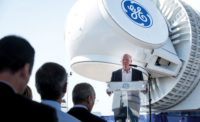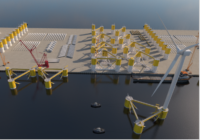"Nimble" is not a word often associated with the nuclear industry. But following the Fukushima Daiichi disaster on March 11, nuclear experts from multiple countries and companies flew to the aid of the Tokyo Electric Power Corp. to help bring its nuclear plant under control and evaluate and mitigate the damage.
Babcock and Wilcox, Charlotte, N.C., provided a remotely operated vehicle to inspect the plant's damage. The Energy Dept.'s Idaho National Laboratories sent a robot designed to withstand high levels of radiation. Paris-based Areva supplied a water decontamination system.
"I think the Japanese were drawing on expertise, whether it was French, Korean, U.S.," says David Modeen, director of external affairs for the nuclear sector of the Electric Power Research Institute (EPRI), Charlotte, N.C. EPRI has provided a team of experts to help TEPCO evaluate its options and plan for the plant's long-term dismantling.
"We all realized the significance of this event and the need to manage it as best as possible," says Modeen.
That response, from what is called the industry response team, will likely continue at Fukushima for at least a decade. Recently, Baton Rouge, La.-based Shaw Group detailed one part of its agile response to the disaster: a water filtering system that moved to installation from concept in just three months.
"It was really a crash effort on the part of the team to make this work," says Jeff Merrifield, senior vice president for Shaw. Such a system typically takes between 18 to 24 months to design, manufacture and install. The canisters are being manufactured in the U.S. before being shipped to Japan, but Merrifield expects they eventually will be manufactured in Japan.
Shaw designed the system, called the simplified active water retrieve and recovery system (SARRY) with Toshiba in conjunction with Columbia, S.C.-based AVANTech Inc. It uses ion-exchange materials from UOP, a unit of Honeywell.
The system consists of two series of seven canisters in parallel. Each canister is about 4.6 ft in dia, 11.8 ft tall, and weighs 24 tons. About 50 tons of water an hour is filtered through the canisters sequentially for treatment, Merrifield says.
When a canister has filtered its maximum amount of radiation—200,000 curies—about every seven to 10 days, the canister is changed out by remote equipment, Merrifield says. TEPCO has not yet decided how it will handle its radioactive waste, so the canisters are being stored safely.
The system will be used indefinitely because the water, once filtered, helps cool the reactors and then is refiltered.
Leakage
Apparently, however, not all of the water is being kept inside the plant. TEPCO reported earlier this month that some radioactive water had spilled out of a desalination unit at Fukushima. The Japanese government ordered TEPCO to install monitors to ensure such spills don't occur again. Shaw says its SARRY system was not involved in the leak. Shaw and Bechtel are among firms contributing to a 10-year Fukushima cleanup and remediation plan.
"Our involvement right now is of a technical nature which draws upon our nuclear accident recovery experience at Three Mile Island Unit 2 and Chernobyl and nuclear decommissioning and cleanup experience at commercial and government nuclear facilities," says Bechtel spokeswoman Michelle Michael. "Over the last 10 months, Bechtel has sent several technical experts in the areas of civil structure, electrical and nuclear-fuel handling to Japan as members of the team."
Bechtel and Hitachi are working on conceptual designs for reactor-fuel characterization and removal, damaged fuel storage and transportation, and contaminated waste disposal, she says.
Shaw's proprietary innovation is not likely to be the last spawned by the disaster. "Just from the size of the event," says Modeen, "you're probably going to see some big things."




Post a comment to this article
Report Abusive Comment